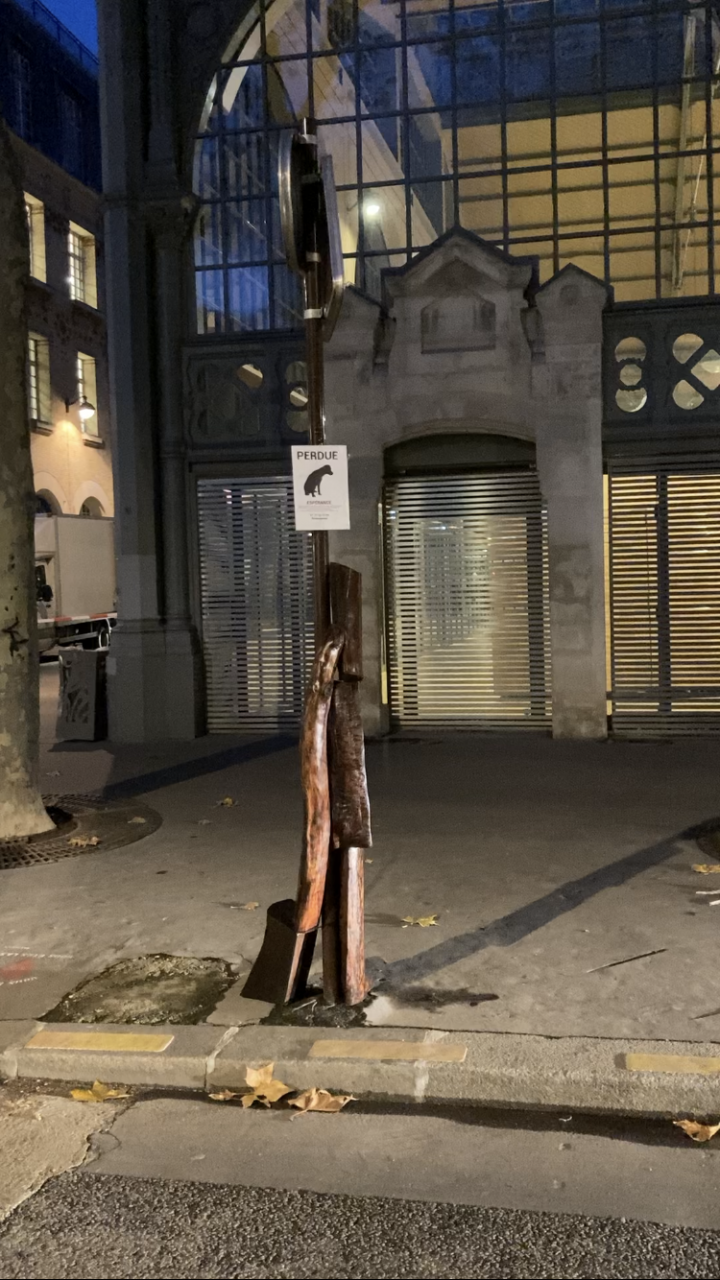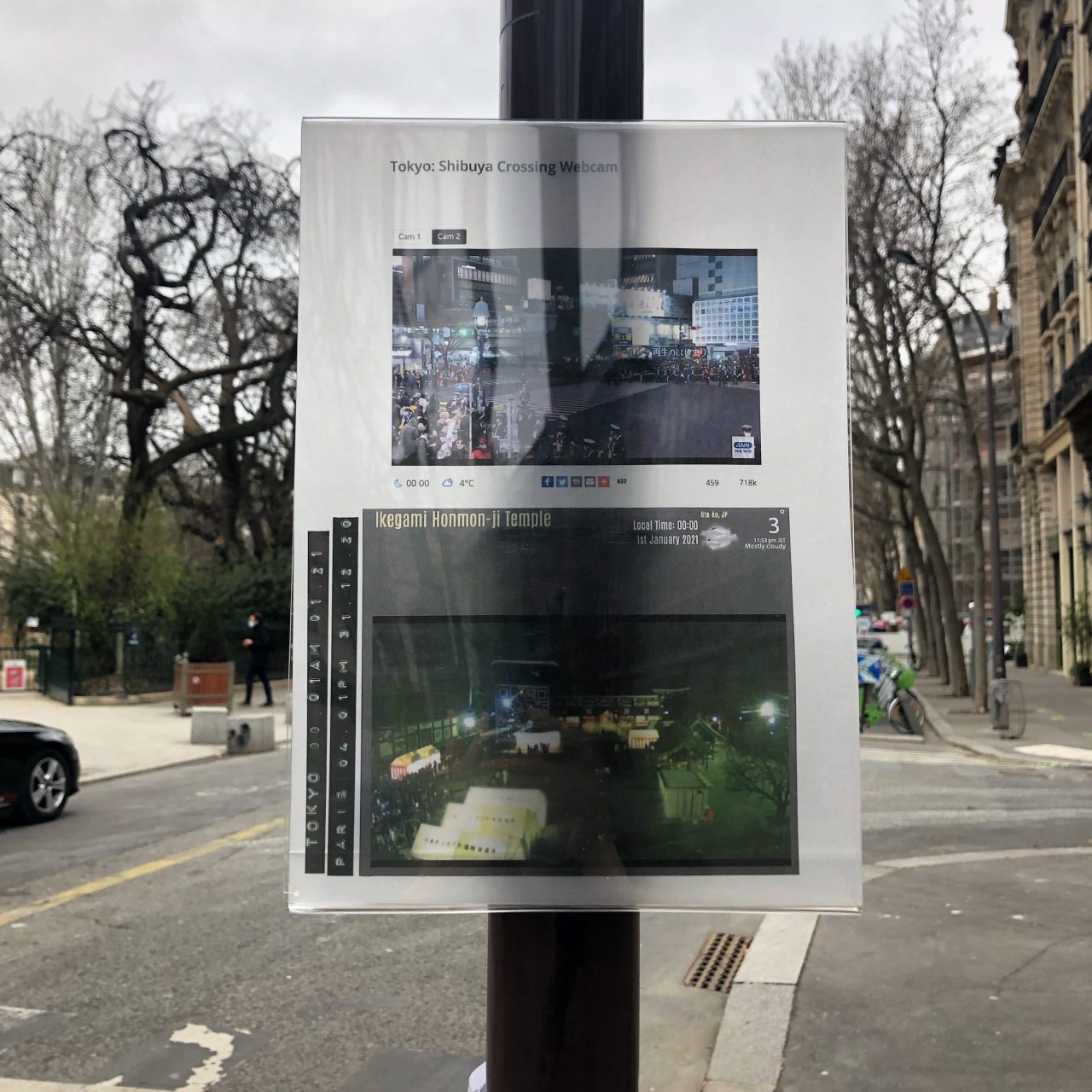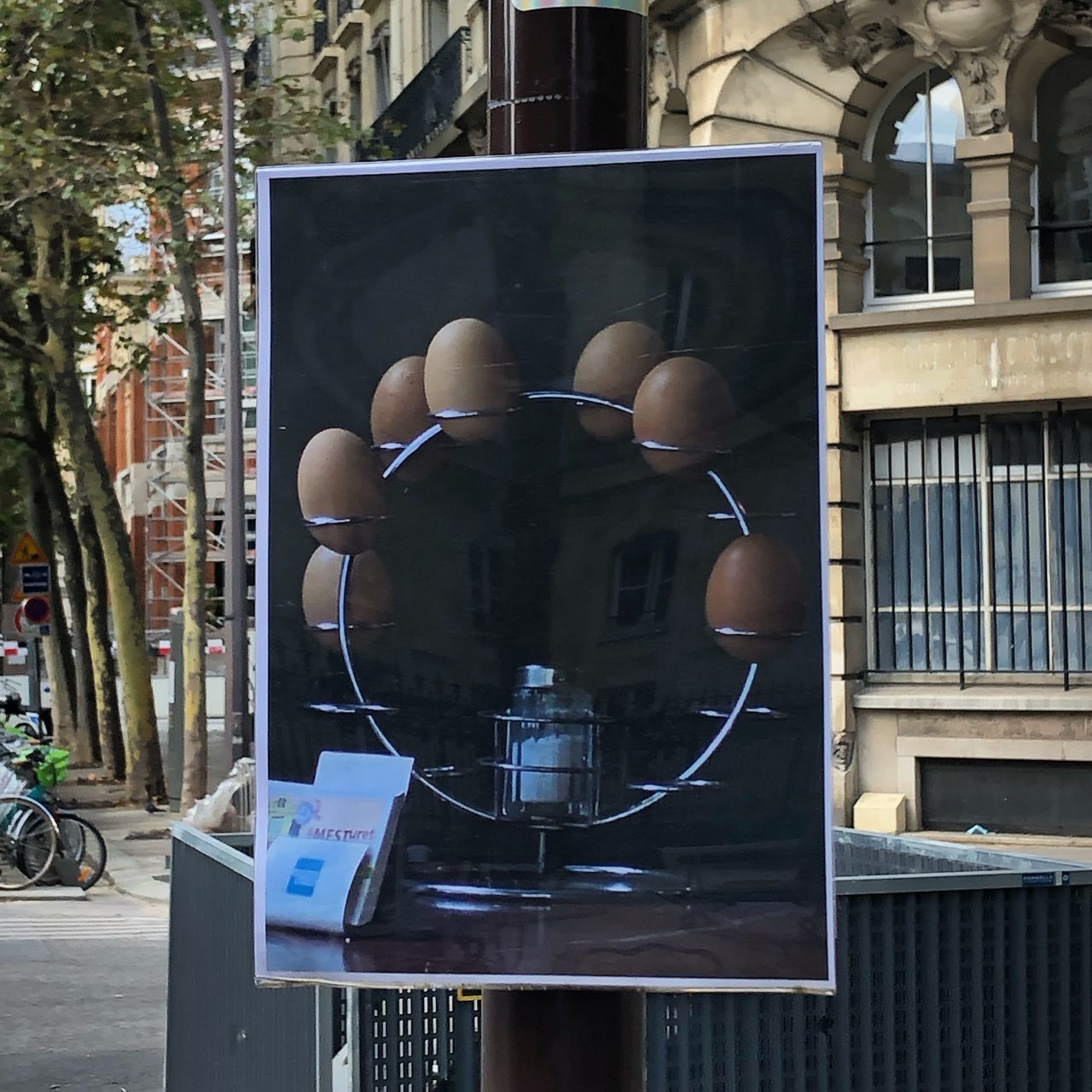In dialogue with
The Pole Gallery in Paris
Amidst the low hum of anxious chatter, I find myself yearning for the tranquil space of the museum. This is an institution dedicated to the campaign against entropy, an enterprise as commendable as it is futile. The first museums were designed to showcase a seamless chronology of a nation through its accumulated art and artefacts—put side by side, these treasures asserted their role as custodians of history and culture. Under the right conditions, in a sterile space, with humidity levels just right, away from dust and dirt, the gradual onset of disorder may be stalled indefinitely.
This desire to transcend time—to step out of it entirely—is reflected in a particular museum aesthetic. Throughout the twentieth century, the “white cube” approach, with its characteristic bare walls, high ceilings, lack of furniture, and white space, was designed to annihilate our very sense of place. This “eternal display” was notably examined in Brian O’Doherty’s Inside the White Cube: The Ideology of the Gallery Space. For an artwork to be fully perceived, he writes, it must be stripped from all existing context. The spectator may then enter the space as a “disembodied eye,” free from bodily distraction.[1] However, such a context, one that seeks to erase itself, might also erase the very objects it contains—one is more likely to notice the staggering whiteness of the space before noticing the art. Such rooms have since been variously labelled as uncomfortable, intimidating, and, for one critic, a “Stanley Kubrick space station.”[2] The experience of empty space, far from being a palliative nod to timelessness, can be jarringly dystopian.
A sense of perpetual disjunction is not new or indeed rare—many have argued that it is modernity’s defining feature. In his 1992 Introduction to an Anthropology of Supermodernity, Marc Augé put forth a concept of non-lieux or “non-places”—spaces of anonymity where “human residue” is not permitted to accumulate. Malls, waiting rooms, supermarkets, and airports are a few such examples—they lack defining features and inhibit communal experience, offering only pockets of provisional solitude.[3] In today’s large, ever-expanding “mega-museums,” one’s experience is similarly governed by an excess of space, seemingly panoptic control, and the uncanny acceleration of time. At the entrance, for instance, one’s identity is checked, ticket stamped, bag and coat assigned to an arbitrary cupboard. After a labyrinth of high-ceilinged galleries which look more or less the same, one finishes at the gift shop clutching the requisite bundle of postcards. Writing about his experience at the Tate Modern, Alan Michael Parker notes the curious tension between the museum’s offering of intimate experience on the one hand and its instant commodification of identity on the other.[4]
But our sense of space and place is fluid, changing, and subject to continual reconstruction—what I consider a non-place may hold a different significance for someone else. In The Practice of Everyday Life (1980), the cultural scholar Michel de Certeau offered a set of distinctions which has since grown in influence—while place implies a stable “instantaneous configuration of positions,” space is very simply the practice of living and walking, comprised of ”vectors of direction, velocities, and time variables.”[5] One of de Certeau’s most notable contributions to contemporary cultural thought has been the extension of literary theory into spatial praxis. As creatures of story, we make sense of the world by continually constructing narratives—linked sequences of meaningful events—which are then integrated into our existing sets of beliefs, desires, and experiences. Widening its application beyond the field of narrative psychology, de Certeau likens the act of walking to a speech act in which movement “continuously presenc(es) previous experience in present contexts’ to create ‘spatial stories’.”[6] Rather than detract from perception, then, as claimed by proponents of the white cube, it can be a gateway to deeper understanding—one comes to know “the world through the body and the body through the world.”[7]
If narrative is the synthesis of heterogenous elements, as Paul Ricoeur claimed,[8] then the museum provides fertile ground to explore the complex relation between story and space. In the museum, visitors move from artwork, to wall, to text panel, to another exhibit, inadvertently “writing” an intricately-patterned narrative of their own. Echoing de Certeau, Jean-Francois Lyotard said of the landmark exhibition Les immatérieux that the visitor’s moving body resembled that of the protagonist in a nineteenth-century novel.[9] Much like the process of reading, it is the ongoing assimilation of disparate elements that creates an overarching illusion of cultural or historical continuity. And so, rather than a container to be filled, the museum can be thought of as the binding to the pages of a book. While there exist numerous museums dedicated to the literary—Prague’s Kafka Museum, The Eric Carle Museum of Picture Book Art in Amherst, and The Story Museum in Oxford, to name a few—there is perhaps only one museum curated in tandem with a novel and canvassing the contents of a fictional mind.

Antoine Espinasseau, image courtesy of the pole gallery 
Delphine Miquel, image courtesy of the pole gallery
I walked into The Museum of Innocence—a modest townhouse in the middle-class neighborhood of Çukurcuma—on a cold Istanbul day. The Turkish writer Orhan Pamuk had collected more than a thousand knick-knacks, from a host of junk and antique shops, while writing its companion novel of the same name. On the first floor, visitors are greeted by a display of exactly 4213 cigarette butts, each with its own scrawled description. Ascending the stairs, one finds 83 numbered display cases arranged in chronological order. Here we see disparate objects set alongside one another—a quince grater, a pair of high heels, framed photographs, magazine cut-outs—illustrating the almost decade-long ordeal of Kemal Basmaci’s unreciprocated love. Pamuk had had the museum designed so that one could take in the whole collection with a single sweep of one’s gaze; the result is a sense of stifling intimacy. While the protagonist finds apparent joy in the collection that invokes his lost lover, we almost pity the man for his obsession, his purity of memory, his naive aspiration toward permanence, indeed his innocence.
Memory is one of the most intimate components of the self, and is core to personal identity. In the face of grief, one suspects that it is the erasure of the evidence, rather than its preservation and subsequent display, that may prove restorative. By transposing objects into a space of narrative memory, and then opening the door to perfect strangers, a place emerges that is also a virtual extension of the mind. In an act that converges space, remembrance, and narrative, we are offered engagement not just with the material remnants of history, but the emotional, psychological, and cultural resonances that accompany these items. It is also remarkable that the very process of building The Museum of Innocence was not one of collecting for a catalogue, but that of simultaneous, mutual construction. Such a mixture of serendipity and design conflates fiction and reality while probing the notion of authentic history: Does it matter if Kemal had really lived or not? What makes someone’s private history “legitimate”? How many people living in twentieth-century Istanbul, whose own stories were left untold, would find resonance with this one? By the entrance, a framed manifesto calls for the reconsideration of the museum’s raison d’être—rather than demonstrating the historical and cultural might of a nation, its imperative must shift to “tell(ing) stories on a human scale.”[10] The personal, Pamuk seems to be saying, is not merely political—it is, or has become, profoundly historical.
We have moved from being passive spectators of history to proponents of its unfolding, or so we would like to think. If “historical” implies “worthy of posterity,” we are certainly seeing a new impulse to cinematize—an impulse unique, perhaps, to the age of social media and the desire to appear relatable yet extraordinary. “We all have main character energy now,” reads a New Yorker article describing the TikTok trend in which seemingly ordinary scenes are accompanied by atmospheric soundtracks and perhaps a hazy filter or two. [11] To channel #maincharacterenergy is to confer upon such moments—dancing alone in a room, bathing a puppy, sitting on a park bench—the poignance of a 1920s period piece or a lugubrious coming-of-age film. The trend spiked last year when, as the world re-opened its doors, one felt understandably compelled to reclaim a sense of agency. One’s life is not provisionary, such a scene seems to say. Can’t you see that it has consequence, even if the film is still rolling? While this may seem to veer dangerously into narcissism, the propensity to see life as art stems as far back as ancient Greek thought on attaining lived fulfilment. More recently, Michel Foucault proposed an aesthetics of existence, likening both life and art to creative, ongoing projects that are sculpted toward a certain evolving vision.[12] The self has become subject—we are director, actor, and audience, curator, centerpiece, and crowd.
In an era that conflates life and art, taking up space is an active assertion of one’s own story. If The Museum of Innocence insists on nostalgia through its display of material remembrance, another aim might be catharsis, or the release from painful emotion. To this end, the Museum of Broken Relationships in Zagreb collapses traditional boundaries—between collection and exhibition, visitor and artist, art and artefact—to turn private anguish into public good. I visited the museum several weeks ago, housed in a charming, baroque uptown building. Collected are a surprising array of things—break-up paraphernalia ranging from the conventional (jewellery, clothes, plush toys) to the eclectic (mannequin), to the bodily (a small bag of belly button lint, a 27-year old scab, and sawn-off dreadlocks), accompanied by descriptions ranging from a phrase to several paragraphs. Each item has been publicly sourced as a vessel of a certain painful memory.
Moving through the rooms, I feel less like I am narrating a novel than perusing an anthology of poems, each powerfully different. In the small space, we enact a careful choreography. We dodge and weave, and in the squeezier corners, sidestep with whispered apology. Step backward, move right, shuffle so that someone can crane their head to read the text panel. I am for several moments transported by the sight of a small rubber pig. The reverie shatters when, out of the corner of my eye, I sense movement—fingers crinkling the pamphlet, the flick of a wrist, a whisper. Have I lingered too long? I step deferentially to the next exhibit. This brings to mind a pilgrim on an extended spiritual journey, stopping at certain sites for contemplation or prayer. The objects are souvenirs—given context, they become artefacts. And gathered in the same space, they acquire the sanctity of relics. They enter into dialogue, telling of vastly different experiences of the same amorphous phenomenon, opening avenues for quiet kinship. Like the items in Kemal’s collection, the terse triviality of each item makes it all the more compelling.
Aside from their devotion to lost connection and their conflation of private with public, both the Museums of Innocence and “Brokenships” bring something else to mind—the “pre-modern” cabinets of curiosity from which modern museums sprang. In Frans Francken’s painting of such a seventeenth-century room, we see a spread of tropical seashells and shark teeth alongside a collection of Roman and Greek coins and surrounded by a host of religious paintings. In such early cabinets, it was not uncommon to encounter, set in close proximity, works of art and craft, plant specimens, taxidermized animals, mechanical gadgets, and scientific tools. If these wunderkammer or “wonder rooms” are now dismissed as artless and unsophisticated—a hodgepodge cupboard of child’s toys—this is because they were often unlabelled, incongruously arranged, and organized by the whims of a single collector. They lacked a system of signification that would not only confer upon each object a meaning but integrate it into a broader narrative.
But we might do well with more rooms like this—modern cabinets of curiosity that delight in the various and multiple, that embrace the astonishing connections between seemingly unrelated phenomena. Indeed, the very nature of our perception is such that looking “sideways” across an object, rather than straight at it, can engender rather different nuances of understanding. The unruly juxtaposition of objects, while suggesting negligence, served a crucial function—as guests moved through the space, it would incite imagination, enliven conversation, and provoke speculation about the world’s kaleidoscopic diversity.[13] The modern cabinet of curiosities, then, offers a similar richness of hue—a means to reimagine the scope and possibility of museum collections while raising important questions about the past and the future, and our place in it. Rather than organize the world by “breaking it down,”[14] it can spur creativity and revitalize our curiosity in an age in which knowledge, in its boundlessness, has become banal. As Steven Lubar puts it, “each object was wonderful in itself, and at the same time revealed the secrets of the world.”[15] Perhaps the analogy again needs reworking: The museum offers not only a novel, but a puzzle endlessly in the assembling—an experience frustrating as it is fascinating and, if you are lucky, rewarding.
At the onset of the pandemic, it was uncertain whether museums as physical spaces would survive. Bodies in enclosed rooms, once merely impediments to the consummation of aesthetic experience, were now a biohazard. Although museums have since found their feet again, it remains a sobering prospect. I hope to have shown that the modern museum plays an important and understated role in revealing the intimate and complex relation between narrative, self, and space—how they change, construct, or diminish each other. They pose compelling questions regarding the experience of the moving body in a continually shifting space of story, as well as the contextual significance of objects and the myriad ways in which we encounter them.
Out in the open air again, there is admittedly a rush of release. Perhaps we enter such spaces – variously configured, often surprising – in order to transport ourselves, linger, and step back into our real lives. Let’s not allow museums to become the untended back gardens of the world—they have much to offer.
The Pole Gallery, Paris





The idea for The pole gallery Paris cropped up in what seems today like a faraway moment in time, 2020, when we were all locked away in our homes and barely realised how much we all missed each other, being outdoors and crossing paths with strangers. I reached out to Orfeo Tagiuri – who had first launched the gallery in London in 2019, and we agreed to have a Paris pole gallery in Carreau du Temple, in Paris’ 3rd arrondissement. Like the London pole gallery, it simply consisted of an A4 plexiglass frame fastened to a street pole, where each artist would be presented for 10 days.
The unwritten mission of the pole gallery is threefold: it aspires to emancipate the presentation of art from closed (literally closed due to the pandemic) gallery, museum, foundation spaces, secondly, it invites us to return to the joys of smaller, more human-scale artworks, and finally, it creates the possibility of an unplanned encounter with art.
Since launching in November 2020, The pole gallery Paris has proudly presented the work of 44 artists, who all contributed to this little project with incredible generosity of their time, each one in their own very personal way. Some showed one work over ten days, some chose to show one new work each day, some chose to transform the shape of the pole, and others even took us as far as the Alps, Milano, Palaia and even Tokyo, where pole galleries were set up spontaneously by the artists themselves or friends who wanted to support the project.
References
Alan Michael Parker. “Non-Places, Megamuseums, and Democracy,” Believer, November 1, 2007, https://believermag.com/non-places-megamuseums-and-democracy/
Brian O’Doherty. Inside the White Cube: The Ideology of the Gallery Space. University of California Press, 1999.
Celeste Olalquiaga. “OBJECT LESSON/TRANSITIONAL OBJECT: The cabinet of Baron de la Mosson,” Cabinet, Winter 2005-2006, https://www.cabinetmagazine.org/issues/20/olalquiaga.php
Christopher Tilley, The Phenomenology of Landscape (London, 1992), 28.
Jean-François Lyotard. “Les immatériaux,” Thinking about exhibitions (1996): 159-173.
Jonathan Jones, “White cube galleries are beautiful. They bore me rigid.” The Guardian, October 12. 2015. https://www.theguardian.com/artanddesign/jonathanjonesblog/2015/oct/12/white-cube-art-galleries-damien-hirst
Kyle Chayka. “We all have main-character energy now,” Infinite Scroll, New Yorker, June 23, 202, https://www.newyorker.com/culture/infinite-scroll/we-all-have-main-character-energy-now?source=search_google_dsa_paid&gclid=Cj0KCQjw8_qRBhCXARIsAE2AtRahb7RTO5DPIocLWarN2aqcSOLe7KMpVr4H9_t6fXcbvMUbMOCBFq4aAiU3EALw_wcB
Lubar, Steven. 2018. “Cabinets of Curiosity.” Steven Lubar. Medium. 1 October. https://lubar.medium.com/cabinets-of-curiosity-a134f65c115a
Marc Augé. Non-places: Introduction to an Anthropology of Supermodernity. Verso, 1995.
Michel de Certeau, Michel, The Practice of Everyday Life. trans. Steven Rendall. Berkeley, (California: University of California Press, 1984).
Michel Foucault, “An Aesthetics of Existence.” Politics, Philosophy, Culture: Interviews and Other Writings (Routledge, 1977-1984).
Orhan Pamuk. “A Modest Manifesto for Museums.” The Museum of Innocence. https://www.masumiyetmuzesi.org/mani-festo
Paul Ricoeur, “The text as dynamic identity,” Identity of the literary text (1985): 175-88.
Rebecca Solnit. Wanderlust: A history of walking. Penguin, 2001.
Footnote
[1] O’Doherty, Brian. Inside the White Cube: The Ideology of the Gallery Space. University of California Press, 1999.
[2] Jonathan Jones, “White cube galleries are beautiful. They bore me rigid.” The Guardian, October 12. 2015. https://www.theguardian.com/artanddesign/jonathanjonesblog/2015/oct/12/white-cube-art-galleries-damien-hirst
[3] Augé, Marc. Non-places: Introduction to an Anthropology of Supermodernity. Verso, 1995.
[4]Alan Michael Parker. “Non-Places, Megamuseums, and Democracy,” Believer, November 1, 2007, https://believermag.com/non-places-megamuseums-and-democracy/.
[5] Michel de Certeau, Michel, The Practice of Everyday Life. trans. Steven Rendall. Berkeley, (California: University of California Press, 1984).
[6] Christopher Tilley, The Phenomenology of Landscape (London, 1992), 28.
[7] Rebecca Solnit. Wanderlust: A history of walking. Penguin, 2001.
[8] Paul Ricoeur, “The text as dynamic identity,” Identity of the literary text (1985): 175-88.
[9] Jean-François Lyotard. “Les immatériaux,” Thinking about exhibitions (1996): 159-173.
[10] Orhan Pamuk. “A Modest Manifesto for Museums.” The Museum of Innocence. https://www.masumiyetmuzesi.org/mani-festo
[11] Kyle Chayka. “We all have main-character energy now,” Infinite Scroll, New Yorker, June 23, 202, https://www.newyorker.com/culture/infinite-scroll/we-all-have-main-character-energy-now?source=search_google_dsa_paid&gclid=Cj0KCQjw8_qRBhCXARIsAE2AtRahb7RTO5DPIocLWarN2aqcSOLe7KMpVr4H9_t6fXcbvMUbMOCBFq4aAiU3EALw_wcB.
[12] Michel Foucault, “An Aesthetics of Existence.” Politics, Philosophy, Culture: Interviews and Other Writings (Routledge, 1977-1984).
[13] Celeste Olalquiaga. “OBJECT LESSON/TRANSITIONAL OBJECT: The cabinet of Baron de la Mosson,” Cabinet, Winter 2005-2006, https://www.cabinetmagazine.org/issues/20/olalquiaga.php
[14] Lubar, Steven. 2018. ” Cabinets of Curiosity.” Steven Lubar. Medium. 1 October. https://lubar.medium.com/cabinets-of-curiosity-a134f65c115a.
[15] Ibid.
